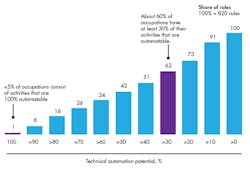Business Directives for the New Automation Age
My previous article on jobs and automation discussed what steps the government could take to help stimulate job growth. A recent research study from the McKinsey Global Institute (MGI), “Jobs Lost, Jobs Gained: Workforce Transitions in a Time of Automation,” discussed the likely future of jobs as automation increases in the labor force.
According to the study, 400 million jobs will be lost to automation. 60% of jobs will see a third of their activities automated rather than being outright eliminated, while only 5% of current jobs will be completely automated. Certain jobs, including those with a physical component, will see a 31% reduction, while professions like infrastructure repair, engineers, architects, and computer engineers will see an increase of 34 to 35%.
The study concluded that both policy makers and business leaders need to be actively involved in promoting job growth. The government needs to actively invest in upgrading the labor force skills via lifelong learning, modernizing education via apprenticeships, providing transition support for workers, battling wage inequality, making job creating a national priority, and modernizing data collection on the labor force to further job placement.
Few occupations will be fully automatable. The research from McKinsey Global Institute shows that 60% of all occupations will see at least 30% of their tasks become automated.
Just as they did with government priorities, the study lists the steps business leaders should be taking to help promote future jobs in automation. Business leaders need to embrace early adoption of automation technologies to gain performance benefits. They will achieve greater efficiency, quality, and speed. Business will be on the front line of the labor work force changes, and successful adoption of automation will not only require them to re-imagine their business processes but also how they acquire talent. Many companies are finding that it best serves them to invest to train and prepare workers for the new work brought on by automation.
Accelerate Deployment of Automation and AI
Only 20% of 3,000 artificial intelligence-aware C-level executives across 10 countries and 14 business sectors confirmed they are adopting AI technology in a core part of their business. This number is too low. For CEOs in all markets, developing strategies to adopt automation and AI should be a priority. Many are uncertain that they will receive a return on their investment. Out of 160 use cases of AI investment, only 12% were deployed commercially.
Companies that ignore these technologies will suffer gap performance from the early adopters that have dived all-in on the technology. According to MGI, AI early adopters have higher profit margins. Case studies reviewed by MGI in electric utilities, manufacturing, healthcare, and education highlight the potential to the technology to improve on forecasting and sourcing, optimized and automated operations, targeted marketing, and enhancements in customer experiences.
Redesign Business Processes for Higher Productivity
Rather than mechanically applying automation to companies’ current activities and processes, a complete re-imagining of how businesses operate is required. Companies need to conduct thorough reviews of processes and workflows to assess where automation can be best implemented. This will result in companies to develop existing workers and acquire new talent that have the discipline and knowledge to harness automation’s full potential.
Rethink Organization Design
As automation becomes more sophisticated, workflows and the way human operators interact with machines will change. Legacy systems and older robotics required significant safety measures, including cages, light curtains, and emergency stops. These measures were aggressive, and activating a safety feature would result in stopped production. Today’s robots and automation machines are more collaborative and have inherent safety measures built-in making them safe for workers without hampering production. Rethinking organizational design ensures that work is more productive and takes advantage of new technical possibilities available. Machine-human and machine-machine environments will become more pervasive. As machines take over tasks, new organizational design will free workers to take on more high-level reasoning tasks that require socialization and emotional reasoning.
Building Digital and Analytic Capabilities
MGI’s analysis shows that companies that adopt AI early are also strong digital leaders. They have strong digital capabilities, making it easier for them to adopt new technology. Companies will need to build strong digital assets, big data and analytic tools and capabilities, and data ecosystems for successful AI and automation adoption.
Adapt New Talent Strategies and Manage Workforce Transitions
New workforces will involve a combination of recruiting automation knowledgeable professionals and retraining workers to play new roles in automation. Companies should be looking toward STEM talent and data scientists, as the importance of these roles will increase along with automation’s expansion. Acquiring new talent will be an expensive endeavor, and data scientists are already in short supply. It may be more affordable for companies to invest in training for their current employees, simultaneously maintaining current workforce levels while promoting lifelong learning skills.
Partnerships for Talent Development
One of the best ways to develop smooth transitions for workers entering the workforce is to collaborate with education institutions. Companies are providing training and skill development to students, so as to ensure they have the appropriate know-how regarding new automation tools once they enter the workforce. Working with schools helps ease the burden on businesses, as the former are responsible for staffing and overhead. Companies provide the content.
These types of partnerships will become more important as the search for talent among an already-scarce talent pool continues. The partnerships can be established not just among universities, but also with community colleges, trade schools, and even high schools.


